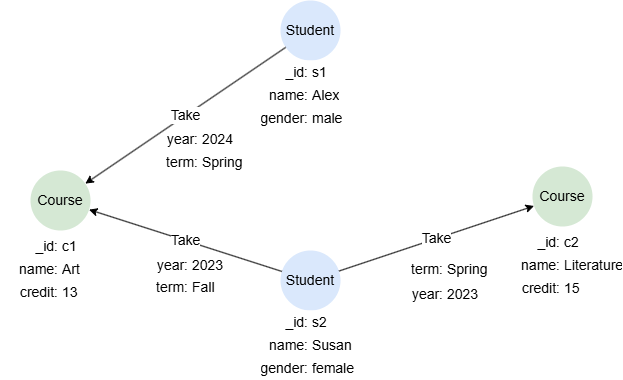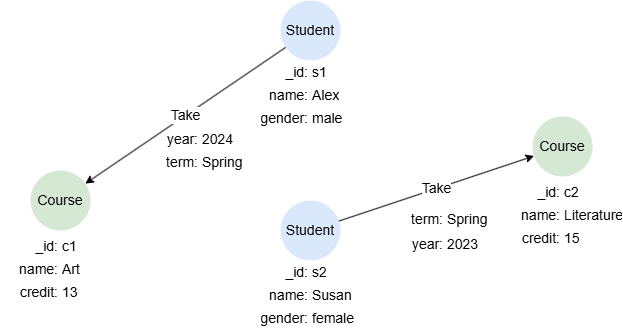Overview
The RETURN statement allows you to specify columns to include in the final table. Each column is defined by an expression that can include variables, properties, functions, constants, etc.
<return statement> ::=
"RETURN" [ <set quantifier> ] { <"*"> | <return item list> }
[ <group by clause> ]
<return item list> ::= <return item> [ { "," <return item> }... ]
<return item> ::= <value expression> [ <return item alias> ]
<return item alias> ::= "AS" <identifier>
<set quantifier> ::= "DISTINCT" | "ALL"
Details
- When the set quantifier
DISTINCTis specified, each return item is an operand of a grouping operation, duplicate records are removed, and only distinct ones are returned. *returns all columns in the current working table.- The keyword
ASis used to rename columns. - The
RETURNstatement supports the use of theGROUP BYclause to group the final table by specifying grouping keys.
Example Graph
The following examples run against this graph:

To create this graph, run the following query against an empty graph:
INSERT (alex:Student {_id: 's1', name: 'Alex', gender: 'male'}),
(susan:Student {_id: 's2', name: 'Susan', gender: 'female'}),
(art:Course {_id: 'c1', name: 'Art', credit: 13}),
(literature:Course {_id: 'c2', name: 'Literature', credit: 15}),
(alex)-[:Take {year: 2024, term: 'Spring'}]->(art),
(susan)-[:Take {year: 2023, term: 'Fall'}]->(art),
(susan)-[:Take {year: 2023, term: 'Spring'}]->(literature)
Returning Nodes
A variable bound to nodes returns the label and properties of each node.
MATCH (n:Course)
RETURN n
Result: n
| _id | _uuid | schema | values |
|---|---|---|---|
| c1 | Sys-gen | Course | {name: "Art", credit: 13} |
| c2 | Sys-gen | Course | {name: "Literature", credit: 15} |
Returning Edges
A variable bound to edges returns the label and properties of each edge.
MATCH ()-[e]->()
RETURN e
Result: e
_uuid |
_from |
_to |
_from_uuid |
_to_uuid |
schema |
values |
|---|---|---|---|---|---|---|
| Sys-gen | s2 | c1 | UUID of s2 | UUID of c1 | Take | {year: 2023, term: "Fall"} |
| Sys-gen | s2 | c2 | UUID of s2 | UUID of c2 | Take | {year: 2023, term: "Spring"} |
| Sys-gen | s1 | c1 | UUID of s1 | UUID of c1 | Take | {year: 2024, term: "Spring"} |
Returning Paths
A variable bound to paths returns the nodes and edges included in each path. Each element includes its label and properties.
MATCH p = ()-[:Take {term: "Spring"}]->()
RETURN p
Result:

| p |
|---|
| (:Student {_id: "s1", gender: "male", name: "Alex"})-[:Take {year: 2024, term: "Spring"}]->(:Course {_id: "c1", name: "Art", credit: 13}) |
| (:Student {_id: "s2", gender: "female", name: "Susan"})-[:Take {year: 2023, term: "Spring"}]->(:Course {_id: "c2", name: "Literature", credit: 15}) |
Returning Labels
The function labels() can be used to return the labels of nodes and edges.
MATCH ({_id: "s2"})-[e]->(n)
RETURN labels(e), labels(n)
Result:
| labels(e) | labels(n) |
|---|---|
| Take | Course |
| Take | Course |
Returning Properties
The period operator . can be used to extract the value of a specified property from a variable bound to nodes or edges. The null value will be returned if the specified property is not found on the nodes or edges.
MATCH (:Student {name:"Susan"})-[]->(c:Course)
RETURN c.name, c.credit, c.type
Result:
| c.name | c.credits | c.type |
|---|---|---|
| Literature | 15 | null |
| Art | 13 | null |
Returning All
* is used to return all columns in the current working table.
MATCH (s:Student {name:"Susan"})-[]->(c:Course)
RETURN *
Result:
s
| _id | _uuid | schema | values |
|---|---|---|---|
| s2 | Sys-gen | Student | {name: "Susan", gender: "female"} |
| s2 | Sys-gen | Student | {name: "Susan", gender: "female"} |
c
| _id | _uuid | schema | values |
|---|---|---|---|
| c1 | Sys-gen | Course | {name: "Art", credit: 13} |
| c2 | Sys-gen | Course | {name: "Literature", credit: 15} |
Column Alias
The keyword AS is used to rename the returned columns.
MATCH (s:Student)-[t:Take]->(c:Course)
RETURN s.name AS Student, c.name AS Course, t.year AS TakenIn
Result:
| Student | Course | TakenIn |
|---|---|---|
| Alex | Art | 2024 |
| Susan | Art | 2023 |
| Susan | Literature | 2023 |
Returning Distinct Records
The DISTINCT set quantifier can be used to return deduplicated records.
MATCH ()-[e]->()
RETURN DISTINCT e.year
Result:
| e.year |
|---|
| 2023 |
| 2024 |
Returning with Aggregation
Aggregation functions, such as sum() and max(), can be directly applied in the RETURN statement.
MATCH (:Student {name:"Susan"})-[]->(c:Course)
RETURN sum(c.credit)
Result:
| sum(c.credit) |
|---|
| 28 |
Returning by CASE
The CASE functions can be directly applied in the RETURN statement.
MATCH (n:Course)
RETURN n.name AS Course, CASE WHEN n.credit > 14 THEN "Y" ELSE "N" END AS Recommended
Result:
| Course | Recommended |
|---|---|
| Art | N |
| Literature | Y |
Returning Limited Records
The LIMIT statement can be used to restrict the number of rows returned.
MATCH (n:Course)
RETURN n.name LIMIT 1
Result:
| n.name |
|---|
| Art |
Returning Ordered Records
The ORDER BY statement can be used to sort the rows according to the specified values.
MATCH (n:Course)
RETURN n ORDER BY n.credit DESC
Result: n
| _id | _uuid | schema | values |
|---|---|---|---|
| c2 | Sys-gen | Course | {name: "Literature", credit: 15} |
| c1 | Sys-gen | Course | {name: "Art", credit: 13} |
Returning with Grouping
The GROUP BY clause can be optionally used to group the final table.
MATCH ()-[e:Take]->()
RETURN e.term AS Term, count(e) GROUP BY Term
Result:
| Term | e.year |
|---|---|
| Spring | 2 |
| Fall | 1 |

